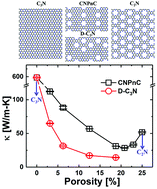Disorder limits the coherent phonon transport in two-dimensional phononic crystal structures†
Abstract
Recently, increasing efforts are being made to control thermal transport via coherent phonons in periodic phononic structures; however, the direct observation of coherent phonon transport is experimentally very difficult at ambient temperature, and the importance of coherent phonons to the total thermal conductivity has not been critically assessed to date. In this study, using the non-equilibrium molecular dynamics simulations, we studied coherent phonon transport in a C3N phononic crystal (CNPnC) structure at room temperature by changing the porosity. When the holes were randomly distributed to construct the disordered C3N (D-C3N) structure, the localization of the coherent phonons was revealed by the phonon transmission coefficient, phonon wave packet simulation, phonon participation ratio and spatial energy density, which led to a significant reduction in the thermal conductivity. Finally, the effects of the length, temperature and strain on the thermal conductivity of CNPnC and D-C3N have also been discussed. Our study provides a solid understanding of the coherent phonon transport behavior, which will be beneficial for phononic-related control based on coherent phonons.



 Please wait while we load your content...
Please wait while we load your content...